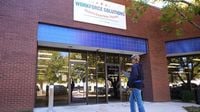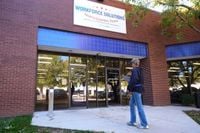For over two weeks, Imelda Avila-Thomas has found herself trapped in a bureaucratic maze, anxiously waiting for help that just won’t come. Like thousands of other furloughed federal workers across the country, she’s been trying to get unemployment compensation to cover basic needs—food, mortgage payments, and the essentials that keep her family afloat—while on unpaid furlough from her job at the Department of Labor in San Antonio. But each time she checks the system, she’s met with the same frustrating message: ineligible for benefits, wages unverifiable. Even after she uploaded her proof-of-income documents earlier this week, the system refused to budge. She can’t help but wonder if the person who might help her is also sitting at home, furloughed and unable to process her claim.
Avila-Thomas is no stranger to public service. She’s worked at the Department of Labor for sixteen years, is a local union leader, and is the mother of a twelve-year-old daughter. Her husband, a disabled veteran, works for the Department of Veterans Affairs and is still receiving his paycheck. But with only one income now, the family has had to make hard choices: cutting back on tutoring for their daughter, who has dyslexia, and even making a trip to the local food bank. “This would cover that — the essential basics,” Avila-Thomas told the Associated Press. “And yes, in an ideal world, everybody would have six months worth of savings. And the reality is, most of our members are coming to that point where they could no longer pay those regular bills.” She’s even applied for part-time work, insisting she isn’t looking for a handout—just a way to keep the lights on until her paycheck resumes.
Her struggle is hardly unique. According to the Bipartisan Policy Center, about 26,000 federal workers filed initial unemployment claims from September 28 through October 18, 2025, a sharp increase but still only a fraction of the more than 670,000 furloughed federal employees affected by the government shutdown. In the week just before the October 1 shutdown, 3,300 workers filed claims. But the process is far from straightforward, and for many, the help is coming too late—if at all.
One of the biggest complications is that unemployment compensation for federal workers relies heavily on state laws and processing systems, and the specifics can vary dramatically. In Massachusetts, for example, the maximum weekly benefit is $1,105 for up to 30 weeks. In Mississippi, it’s just $235 per week for up to 26 weeks. Roughly half the states pay less than $600 a week at maximum, according to U.S. Department of Labor numbers. Some states offer fewer than 20 weeks of benefits, while others extend the duration if unemployment rates are especially high. Around the nation’s capital, the maximum weekly payment ranges from $378 in Virginia to $444 in Washington, D.C., and $430 in Maryland. In Texas, where Avila-Thomas lives, the weekly maximum is $605 for up to 26 weeks.
But getting those payments is another story. States typically issue payments within two to three weeks after a claim is approved, but there’s often an initial “waiting week” for which benefits are not paid up front. Only if claimants exhaust all their allotted weeks do they receive payment for that first week, according to the National Employment Law Project. The real bottleneck, though, is verification: states must confirm an applicant’s job and earnings with their federal employer. And with so many federal agencies shut down, the Department of Labor has warned that this process may be delayed—or grind to a halt entirely. Many furloughed workers haven’t received the forms their agencies usually send to verify their employment and earnings, leaving state agencies unable to move forward with their claims.
There’s also confusion over whether furloughed workers must prove they’re looking for work while receiving unemployment checks. The Labor Department has said that waivers may apply under state laws, since furloughed federal workers face ethical restrictions on outside employment. Some states have waived the work-search mandates for several weeks or longer, but not all. In Texas, Avila-Thomas still hasn’t received a clear answer. Many of the jobs she’s matched with could present a conflict of interest, and the Texas Workforce Commission has yet to clarify the requirement. “It’s just another layer of stress,” she explained. “You want to do the right thing, but you don’t want to risk your job or violate any rules.”
For those federal employees still working without pay—about 730,000 people, according to the Bipartisan Policy Center—unemployment benefits are generally off the table. These “excepted” employees, who include air traffic controllers, airport security screeners, and other workers deemed necessary for emergencies or national security, will receive back pay once the government reopens. Workers on reduced hours may be eligible for partial unemployment, but for most, the only option is to wait and hope.
The Trump administration has added its own twists to the shutdown’s impact. Earlier in October, the administration threatened that back pay for furloughed workers would not be guaranteed, a statement that sent shockwaves through the federal workforce. The White House later reversed its stance, but the uncertainty lingered. Meanwhile, President Trump sought to lay off more than 10,000 federal workers during the shutdown—a move that was quickly blocked by a judge while a lawsuit challenging the layoffs plays out. Some groups, including FBI special agents and military troops, were told their pay would continue. Employees in departments like the Postal Service, which rely on their own revenues, saw no interruption in their paychecks.
Even as the shutdown drags on, Avila-Thomas and her colleagues are trying to keep their spirits up. “We’re ready to get back,” she said. “I think I’ve driven my family crazy with things and projects.” But the reality is that for many federal workers, the financial strain is mounting, and the uncertainty is taking a toll. The shutdown has exposed just how fragile the safety net is for those who dedicate their careers to public service. While some may eventually receive back pay, the immediate need for food, housing, and stability can’t wait for political standoffs to resolve.
The situation has highlighted deep inconsistencies in how unemployment benefits are administered across the country. It’s a patchwork system, with each state setting its own rules, benefit levels, and timelines. For federal workers like Avila-Thomas, navigating this system during a crisis is a daunting task—one that’s made even harder when the very agencies meant to help are themselves closed for business.
As the days tick by, the stories of hardship multiply. Families are dipping into savings, cutting back on essentials, and, in some cases, turning to food banks for the first time. The ripple effects reach far beyond government offices, touching local economies and communities that depend on federal paychecks. And with no clear end in sight, the strain is only likely to grow.
For now, Avila-Thomas and thousands like her wait—hoping for answers, for relief, and above all, for a return to normalcy. Their patience, resilience, and determination are on full display. But as the shutdown continues, the question remains: how much longer can they hold on?


